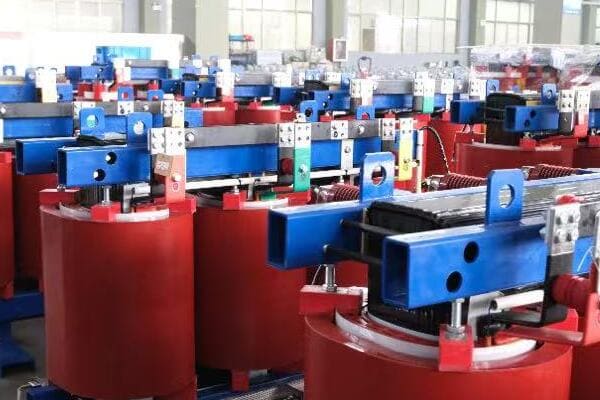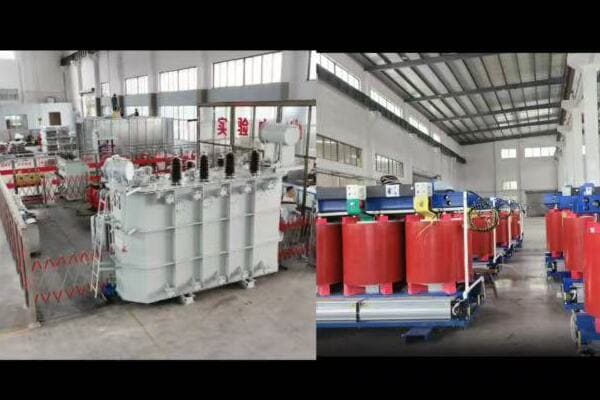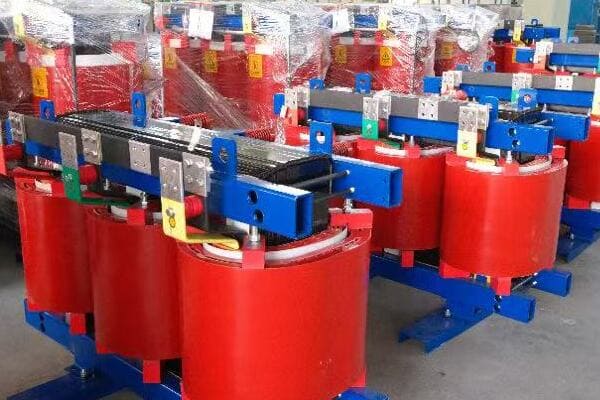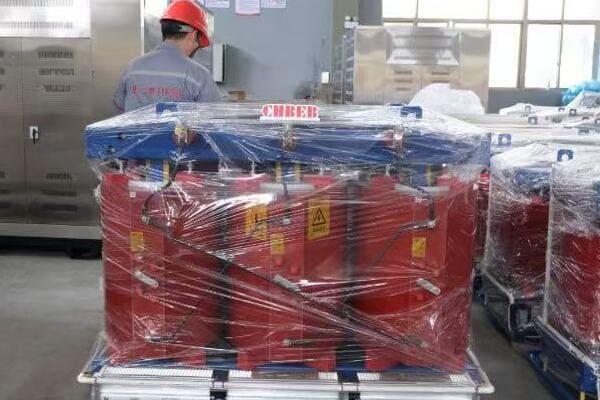What Is a Dry Type Transformer? A Simple Guide for Beginners and Engineers?
Are you confused by the term "dry type transformer" and wondering how it differs from other transformers? You’re not alone. Many professionals and students in the electrical field struggle to understand the unique features and applications of dry type transformers. But what if you could gain a clear, comprehensive understanding of this crucial component in modern electrical systems?
A dry type transformer is a power transformer that uses air instead of liquid for cooling. It is commonly used in indoor or fire-sensitive environments. This guide explains what dry type transformers are, how they work, and where they’re used in modern electrical systems. Understanding these transformers is crucial for anyone involved in electrical engineering or facility management.
In this comprehensive guide, I’ll walk you through everything you need to know about dry type transformers. We’ll explore their basic components, common applications, key advantages, and how they compare to oil-immersed transformers. Whether you’re a beginner or an experienced engineer, this article will provide valuable insights into this essential piece of electrical equipment.
What Does "Dry Type" Really Mean in Transformers?
Have you ever wondered why some transformers are called "dry type" while others are not? The term can be confusing, especially if you’re new to the field of electrical engineering. But what exactly makes a transformer "dry," and how does this differ from other types of transformers?
"Dry type" in transformers refers to the cooling method that doesn’t use any liquid. Instead of oil, these transformers use air or solid insulation materials for cooling and insulation. The core and windings are typically encased in epoxy resin or similar materials, allowing for air circulation to dissipate heat. This design makes them safer and more environmentally friendly than oil-filled transformers.
Understanding Dry Type Transformers
Let’s break down the key aspects of dry type transformers:
- Cooling Method
- Insulation Materials
- Heat Dissipation
- Environmental Considerations
- Safety Features
Cooling Method
Dry type transformers use air for cooling:
- Natural air circulation in smaller units
- Forced air cooling in larger transformers
- No liquid coolant involved
I once visited a facility where the transition from oil-filled to dry type transformers significantly reduced fire hazards and simplified maintenance procedures.
Insulation Materials
Common insulation types include:
- Epoxy resin encapsulation
- Vacuum pressure impregnation (VPI)
- High-temperature insulation materials
During a recent project, I was impressed by how modern epoxy resins provided excellent insulation while allowing for compact transformer designs.
Heat Dissipation
Heat management is crucial:
- Designed for efficient heat transfer to surrounding air
- May include cooling fins or channels for better air flow
- Temperature monitoring systems for larger units
Here’s a quick comparison of cooling methods:
| Method | Heat Dissipation | Typical Application |
|---|---|---|
| Natural Air (AN) | Low to Medium | Small to medium transformers |
| Forced Air (AF) | Medium to High | Larger transformers |
| Epoxy Encapsulated | Medium | Indoor, clean environments |
Environmental Considerations
Dry type transformers offer environmental benefits:
- No risk of oil leaks or spills
- Reduced environmental impact
- Easier disposal at end of life
Safety Features
Enhanced safety is a key feature:
- Reduced fire risk compared to oil-filled transformers
- No need for fire suppression systems in many cases
- Safer for indoor installations
Key points about "dry type" in transformers:
- Air or solid materials are used for cooling instead of oil
- Insulation is typically epoxy resin or similar materials
- Heat dissipation relies on efficient air circulation
- Environmentally friendly due to absence of oil
- Enhanced safety features, especially for fire-sensitive areas
In my experience, understanding the "dry type" concept is crucial for proper transformer selection and application. I recall a case where switching to dry type transformers in a data center not only improved fire safety but also simplified maintenance routines, leading to significant long-term cost savings.
For instance, in a recent project for a hospital expansion, we chose dry type transformers for their safety profile and ease of maintenance. This decision proved invaluable when the hospital later expanded its MRI facilities, as the dry type transformers posed no magnetic interference risks.
As we move on to discuss the basic components of dry type transformers, keep in mind how this unique cooling and insulation method influences their design and functionality. Understanding these basics will help you appreciate the advantages and applications of dry type transformers in various settings.
Basic Components and How They Work Together?
Are you curious about what’s inside a dry type transformer and how its parts function? Understanding the internal workings of these transformers is crucial for anyone involved in electrical engineering or facility management. But what are the key components that make up a dry type transformer, and how do they interact to transform electrical energy efficiently and safely?
Dry type transformers consist of several key components: the core, primary and secondary windings, insulation materials, and a cooling system. The core, typically made of silicon steel, provides a path for magnetic flux. Windings, usually copper or aluminum, create the magnetic field and induce voltage. Insulation, often epoxy resin, separates and protects the windings. The cooling system, which may include fins or fans, dissipates heat generated during operation.
Key Components and Their Functions
Let’s explore the main parts of a dry type transformer:
- Core
- Windings (Primary and Secondary)
- Insulation System
- Cooling Mechanism
- Protective Enclosure
Core
The heart of the transformer:
- Usually made of high-grade silicon steel
- Laminated structure to reduce eddy current losses
- Provides a low reluctance path for magnetic flux
I recently examined a new core design that used advanced amorphous metals, significantly reducing core losses compared to traditional silicon steel.
Windings (Primary and Secondary)
Crucial for voltage transformation:
- Primary winding receives input voltage
- Secondary winding delivers output voltage
- Typically made of copper or aluminum
During a factory tour, I observed the precision winding process, which is critical for maintaining consistent performance and efficiency in dry type transformers.
Insulation System
Essential for safety and performance:
- Epoxy resin encapsulation or vacuum pressure impregnation (VPI)
- Provides electrical insulation between windings and core
- Contributes to heat dissipation
Here’s a comparison of common insulation methods:
| Method | Insulation Material | Advantages |
|---|---|---|
| Cast Resin | Epoxy resin | Excellent moisture resistance |
| VPI | Polyester or epoxy varnish | Good for complex shapes |
| Open Wound | Air and solid insulation | Cost-effective for smaller units |
Cooling Mechanism
Manages heat generated during operation:
- Natural air convection in smaller units
- Forced air cooling with fans in larger transformers
- Heat sinks or cooling fins to increase surface area
Protective Enclosure
Safeguards internal components:
- Provides mechanical protection
- Helps in heat dissipation
- Often includes IP (Ingress Protection) rating for environmental protection
Key points about dry type transformer components:
- The core provides a path for magnetic flux and is crucial for efficiency
- Windings create the magnetic field and induce voltage transformation
- Insulation system protects components and aids in heat management
- Cooling mechanism is essential for maintaining safe operating temperatures
- Protective enclosure ensures safety and environmental protection
In my experience, the interplay between these components is what makes dry type transformers so reliable and efficient. I’ve seen how advancements in materials and design of each component have led to significant improvements in transformer performance over the years.
For example, in a recent project upgrading an old industrial facility, we replaced outdated transformers with modern dry type units. The new transformers, with their advanced core materials and improved insulation systems, not only increased energy efficiency but also reduced the overall footprint of the electrical room.
As we move on to discuss where dry type transformers are commonly used, keep in mind how these basic components work together to provide safe and efficient power transformation in various applications. Understanding this internal structure will help you appreciate why dry type transformers are preferred in certain environments over their oil-filled counterparts.
Where Are Dry Type Transformers Commonly Used?
Have you ever wondered why you might see dry type transformers in certain locations but not others? Understanding the typical applications of these transformers is crucial for anyone involved in electrical system design or facility management. But what specific environments and industries benefit most from dry type transformers, and why are they chosen over other types?
Dry type transformers are commonly used in indoor and environmentally sensitive locations. They’re frequently found in commercial buildings like hospitals and shopping centers, industrial facilities, renewable energy projects, and data centers. Their fire-resistant properties make them ideal for high-rise buildings and underground installations. Dry type transformers are also preferred in areas where oil leaks could be hazardous, such as food processing plants or near water sources.

Common Applications of Dry Type Transformers
Let’s explore the main areas where dry type transformers are typically used:
- Commercial Buildings
- Industrial Facilities
- Renewable Energy Projects
- Data Centers and IT Facilities
- Special Environments
Commercial Buildings
Widely used in various commercial settings:
- Office buildings and high-rise structures
- Hospitals and healthcare facilities
- Shopping malls and retail centers
- Educational institutions
I recently worked on a project for a new hospital wing where dry type transformers were chosen for their safety features and minimal maintenance requirements, crucial in a healthcare setting.
Industrial Facilities
Common in manufacturing and processing plants:
- Chemical and pharmaceutical industries
- Food and beverage processing plants
- Automotive manufacturing facilities
- Textile and paper mills
During a recent upgrade of a food processing plant, we installed dry type transformers to eliminate the risk of oil contamination, a critical factor in food safety.
Renewable Energy Projects
Increasingly used in green energy installations:
- Wind turbine installations (especially in nacelles)
- Solar power plants
- Hydroelectric power stations
- Biomass energy facilities
Here’s a quick overview of dry type transformer applications in renewable energy:
| Energy Source | Application | Key Benefit |
|---|---|---|
| Wind Power | Inside turbine nacelles | Compact size, fire safety |
| Solar Farms | Power conversion stations | Environmental safety |
| Hydroelectric | Generator step-up | Moisture resistance |
Data Centers and IT Facilities
Critical for modern digital infrastructure:
- Server rooms and data centers
- Telecommunications facilities
- Network operation centers
- Cloud computing facilities
I recently designed the power distribution system for a large data center where dry type transformers were essential due to their reliability and reduced fire risk.
Special Environments
Suited for unique or challenging locations:
- Marine and offshore installations
- Underground mining operations
- Public transportation systems (subway stations)
- Hazardous or explosive environments (with proper enclosures)
Key points about dry type transformer applications:
- Ideal for indoor and fire-sensitive environments
- Commonly used in commercial and public buildings
- Preferred in industries where oil leaks could be hazardous
- Essential in modern data centers and IT facilities
- Adaptable to special environments with specific safety requirements
In my experience, the versatility of dry type transformers makes them invaluable in a wide range of applications. I’ve seen how their use can significantly simplify building design and improve safety in various settings.
For instance, in a recent project renovating an old industrial complex into a mixed-use development, we used dry type transformers throughout. This choice not only met stringent urban safety codes but also provided flexibility in transformer placement, crucial for preserving the building’s historical features while modernizing its electrical infrastructure.
As we move on to discuss the key advantages of dry type transformers, keep in mind these diverse applications. Understanding where these transformers are commonly used will help you appreciate why their specific features and benefits are so valuable in modern electrical systems.
Key Advantages of Dry Type Transformers?
Are you wondering why dry type transformers are often preferred in certain applications? Understanding their advantages is crucial for making informed decisions in electrical system design and management. But what specific benefits do dry type transformers offer, and how do these advantages translate into real-world value for users and facility managers?
Dry type transformers offer several key advantages: enhanced fire safety, reduced maintenance requirements, environmental friendliness, and suitability for indoor installations. They eliminate the risk of oil leaks, require no oil monitoring or replacement, and have a smaller footprint compared to oil-filled units. These transformers are also more resistant to moisture and contaminants, making them ideal for harsh environments. Their eco-friendly nature and lower lifecycle costs are increasingly valued in modern applications.
Exploring the Benefits of Dry Type Transformers
Let’s delve into the main advantages:
- Enhanced Safety Features
- Reduced Maintenance Requirements
- Environmental Benefits
- Installation Flexibility
- Long-Term Cost Effectiveness
Enhanced Safety Features
Crucial for many applications:
- Significantly lower fire risk compared to oil-filled transformers
- No risk of oil leaks or spills
- Suitable for installation near populated areas
I recall a project where switching to dry type transformers in a high-rise office building dramatically simplified fire safety compliance and reduced insurance costs.
Reduced Maintenance Requirements
Simplifies long-term operations:
- No need for regular oil testing or replacement
- Less frequent inspections required
- Lower risk of component degradation
During a recent facility audit, I noticed how dry type transformers installed a decade ago required minimal maintenance compared to their oil-filled counterparts.
Environmental Benefits
Increasingly important in modern designs:
- No risk of soil or water contamination from oil leaks
- Easier and more environmentally friendly disposal at end of life
- Often made with recyclable materials
Here’s a quick comparison of environmental aspects:
| Aspect | Dry Type | Oil-Filled |
|---|---|---|
| Risk of Leaks | None | Possible |
| Environmental Impact | Low | Moderate to High |
| End-of-Life Disposal | Simpler | More Complex |
Installation Flexibility
Adaptable to various settings:
- Compact design allows for installation in confined spaces
- Can be installed indoors, closer to load centers
- Suitable for mobile or temporary installations
I recently designed a power system for a modular data center where the compact nature of dry type transformers was crucial for the project’s success.
Long-Term Cost Effectiveness
Provides economic benefits over time:
- Lower installation costs (no need for oil containment systems)
- Reduced insurance premiums due to lower fire risk
- Longer lifespan with proper maintenance
Key advantages of dry type transformers:
- Significantly enhanced safety, especially in fire-sensitive areas
- Minimal maintenance requirements, reducing operational costs
- Environmentally friendly with no risk of oil contamination
- Flexible installation options, including indoor and confined spaces
- Cost-effective over the long term, despite higher initial costs
In my experience, these advantages often make dry type transformers the preferred choice in modern electrical systems. I’ve seen numerous cases where their benefits have led to improved safety, reduced operational headaches, and long-term cost savings.
For example, in a recent project upgrading the electrical system of a university campus, we chose dry type transformers for their safety features and low maintenance needs. This decision not only improved campus safety but also allowed for more flexible placement of electrical rooms, crucial in the campus’s space-constrained environment.
As we move on to compare dry type and oil-immersed transformers, keep these advantages in mind. Understanding the strengths of dry type transformers will help you make more informed decisions when choosing between different transformer types for specific applications.
Dry Type vs Oil Immersed: When to Use Each?
Are you struggling to decide between dry type and oil-immersed transformers for your project? This choice can significantly impact the safety, efficiency, and long-term costs of your electrical system. But how do you determine which type is best suited for your specific needs, and what factors should you consider in making this decision?
Dry type transformers are ideal for indoor installations, fire-sensitive areas, and environments where oil leaks could be hazardous. They’re preferred in commercial buildings, hospitals, and data centers. Oil-immersed transformers are better suited for outdoor installations, high-voltage applications, and where cost is a primary concern. The choice depends on factors like installation location, environmental conditions, maintenance capabilities, and specific safety requirements of the application.

Comparing Dry Type and Oil-Immersed Transformers
Let’s explore the key factors to consider:
- Installation Environment
- Safety Considerations
- Maintenance Requirements
- Cost Factors
- Performance Characteristics
Installation Environment
Key considerations for installation:
- Dry type: Ideal for indoor, confined spaces, and environmentally sensitive areas
- Oil-immersed: Better suited for outdoor installations and harsh environments
I recently worked on a project where we chose dry type transformers for a new hospital wing due to strict fire safety regulations, while opting for oil-immersed units for the outdoor substation.
Safety Considerations
Critical factors in transformer selection:
- Dry type: Lower fire risk, no oil leakage concerns
- Oil-immersed: Higher fire risk, potential environmental hazard from oil leaks
During a risk assessment for a data center, the reduced fire risk of dry type transformers was a decisive factor in their selection over oil-immersed units.
Maintenance Requirements
Long-term operational considerations:
- Dry type: Minimal maintenance, no oil monitoring or replacement
- Oil-immersed: Regular oil testing and potential oil replacement
Here’s a quick comparison of maintenance aspects:
| Aspect | Dry Type | Oil-Immersed |
|---|---|---|
| Routine Checks | Less frequent | Regular |
| Oil Maintenance | None | Periodic testing and replacement |
| Lifespan | 20-30 years | 30-40 years with proper maintenance |
Cost Factors
Financial considerations over the lifecycle:
- Dry type: Higher initial cost, lower maintenance costs
- Oil-immersed: Lower initial cost, higher maintenance and potential environmental costs
I recall a project where the long-term cost analysis favored dry type transformers despite their higher upfront cost, due to reduced maintenance and insurance expenses.
Performance Characteristics
Operational differences:
- Dry type: Generally used for lower voltage applications (up to 35kV)
- Oil-immersed: Suitable for higher voltages and larger capacities
Key points for choosing between dry type and oil-immersed transformers:
- Installation environment is a crucial factor in the decision
- Safety requirements often favor dry type in sensitive areas
- Maintenance needs are significantly lower for dry type transformers
- Long-term cost analysis may favor dry type despite higher initial costs
- Performance requirements, especially voltage levels, influence the choice
In my experience, the decision between dry type and oil-immersed transformers often comes down to a careful balance of these factors. I’ve seen cases where the choice wasn’t immediately obvious and required a thorough analysis of the specific project requirements.
For instance, in a recent industrial project, we initially considered oil-immersed transformers for their cost-effectiveness. However, after a comprehensive risk assessment and long-term cost analysis, we opted for dry type units. The decision was driven by the proximity to sensitive manufacturing processes and the potential long-term savings in maintenance and environmental compliance.
CHBEB, as a leading manufacturer, offers a range of both dry type and oil-immersed transformers. Their expertise has been particularly valuable in projects requiring customized solutions. For example, in a recent project for a Middle Eastern hospital, CHBEB provided specially designed moisture-resistant dry type transformers that could withstand the region’s high humidity while meeting strict safety standards.
When making your decision, consider not just the immediate needs but also future expansion plans, potential changes in regulations, and the overall lifecycle costs. Remember, the right choice depends on your specific application, environment, and long-term operational strategy.
Conclusion
Dry type transformers offer unique advantages in safety, maintenance, and environmental friendliness, making them ideal for indoor and sensitive installations. While oil-immersed transformers have their place in certain applications, the choice between the two depends on specific project requirements, environmental conditions, and long-term operational considerations.
Remember, at chbeb-ele, we’re not just sharing information – we’re empowering you to be part of the solution in creating a secure, clean, and efficient energy future. Let’s continue this journey together.
Free CHBEB Transformer Catalog Download
Get the full range of CHBEB transformers in one catalog.
Includes oil-immersed, dry-type, pad-mounted, and custom solutions.
Quick Message
Request A free quote
We'd like to work with you
- +86 15558785111
- [email protected]
- +86 15558785111
What We Do
CHINA BEI ER BIAN (CHBEB) GROUP, with 218 million in registered capital, originated from Beijing Beierbian Transformer Group. Headquartered in Beijing for R&D, it operates major production bases in Nanjing and Yueqing, producing high-quality products.
Latest Product
address
BeiJing
No 3,RongJing East Road,BeiJing Economic Technological Development Area,BeiJing,China
JiangSu
No 7️Xiangfeng Road,Jiangning,NanJing,JiangSu,China
WenZhou
No.211, Wei 16 Road, Industrial Zone, Yueqing, Wenzhou, Zhejiang, China.
XiangYang Industrial Zone ,YueQing,WenZhou,ZheJiang,China
contact us
- [email protected]
- +86 13057780111
- +86 13057780111
- +86 15558785111
Copyright © Bei Er Bian Group






